Fish Stock Recipe: Make Now, Freeze For Future Meals
Views: 207
Picture this: you’re at the fishmonger, picking up some fresh fish for dinner and planning to get a fillet. The person behind the counter asks, “Would you like the bones and head?” Likely, you politely decline, envisioning a smelly kitchen and waste. However, by saying “no,” you’re passing up a key ingredient for a rich, flavorful homemade fish stock that could turn your seafood meals from good to gourmet. Unsurprisingly, the next time you need fish broth or fish stock for clam chowder or Cioppino, you’ll probably head to a specialty store. Chances are, you’ll find in-store-made fish stock, maybe labeled as “fish fumet”, proudly displayed—and shockingly expensive. But here’s a little secret: making fish stock at home is cheap and incredibly simple, even for a novice cook.
You can jump straight to the recipe or stick around to explore helpful tips, ingredient recommendations, and tricks to make this fish stock truly exceptional. Promise, no grandma stories here!
Fish Stock, Fish Fumet and Fish Broth
When it comes to definitions of fish stock, fish broth, and fish fumet, you’ll likely get different answers depending on who you ask. Some will argue they are distinct, pointing out that fish stock recipes typically call for simmering of fish bones only and that the end product is always thicker. In contrast, fish broth is lighter and made with more fish meat. Others will contend that the terms are essentially interchangeable, with no real difference between fish stock and broth.
In fact, the majority of chefs don’t always differentiate between fish stock and broth. For most of them, it’s not crucial whether you’re sweating vegetables or adding wine—these are still just variations on the same basic concept and the recipe. The same goes for fish fumet. Some might insist that fish fumet is a more refined and concentrated version, typically made with wine and simmered for a shorter time, but others might not see it as a major distinction from fish stock or broth.
So, in the end, call it what you will. Our recipe is for the flavorful liquid made from fish trimmings, vegetables, wine, and aromatics, whether you want to label it stock, broth, or fumet. We chose to call it a recipe for fish stock.
Pro Tips for the Best Fish Stock
When you’re making a fish stock recipe, choosing the right fish trimmings is key to getting a balanced and flavorful result. Not all fish are suited for making fish stock either. So, it’s important to know which ones to avoid.
Best Fish to Use
![]() Generally speaking, salmon and black cod trimmings are not recommended for making fish stock. Here’s is why:
Generally speaking, salmon and black cod trimmings are not recommended for making fish stock. Here’s is why:
Strong, Overpowering Flavors: Salmon and black cod are oily, fatty fish with bold, distinctive flavors. When their bones are simmered, they release these intense flavors, resulting in a stock that’s overly rich, greasy, or too pungent for many dishes. This can overpower the more delicate flavors you want in soups or sauces.
![]() What Fish to Use Instead?
What Fish to Use Instead?
For the best results, use trimmings from white fish like cod, halibut, bass, flounder, or sole. These fish have a milder flavor and fewer oils, which makes them perfect for a stock that’s cleaner, lighter, and more versatile. This kind of stock works as a great base for a wide variety of dishes.
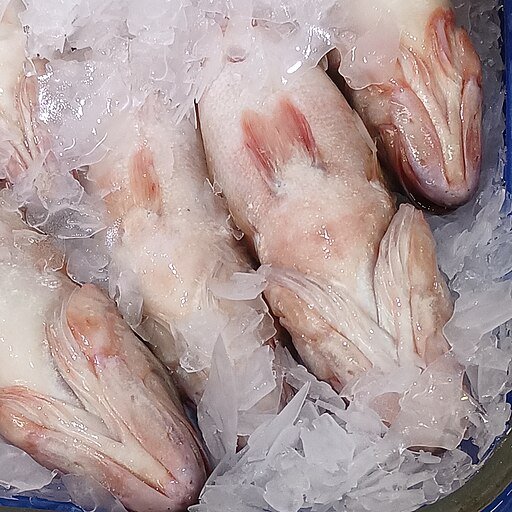
Best Fish Trimmings Kind to Include
![]() To make the most flavorful stock, use fish heads, bones, tails, fins, and collars. Fish collars, the meaty sections just behind the head, are particularly rich in collagen and flavor, making them a fantastic addition. Be sure to avoid internal organs, as they can give your stock a bitter taste.
To make the most flavorful stock, use fish heads, bones, tails, fins, and collars. Fish collars, the meaty sections just behind the head, are particularly rich in collagen and flavor, making them a fantastic addition. Be sure to avoid internal organs, as they can give your stock a bitter taste.
Image: Fumikas Sagisavas, CC0, via Wikimedia Commons
Best Wine to Use in a Fish Stock Recipe
When making a fish stock recipe, adding wine can really boost the flavor by giving it more depth and a bit of acidity. But, it’s important to choose the right wine to get the best results.
The best choice for fish stock is a dry light white wine. It works well with the delicate taste of the fish stock without overpowering it. Look for white wines that aren’t too fruity or sweet, as these can clash with the subtle fish flavors. Additionally, avoid white wines that are heavily oaked, or full-bodied, as these can take over the taste of the stock.
![]() Top Choices Include:
Top Choices Include:
- Sauvignon Blanc: Known for its bright acidity and citrus notes, this wine adds a refreshing layer to the stock.
- Pinot Grigio: With a clean, crisp flavor, Pinot Grigio is another great option. It enhances the stock without making it too heavy or complex.
- Chardonnay (Unoaked): If you like a slightly richer taste, unoaked Chardonnay gives a smooth, buttery flavor without the strong oak influence.
How to Make Lobster Bisque Step by Step Illustrations:
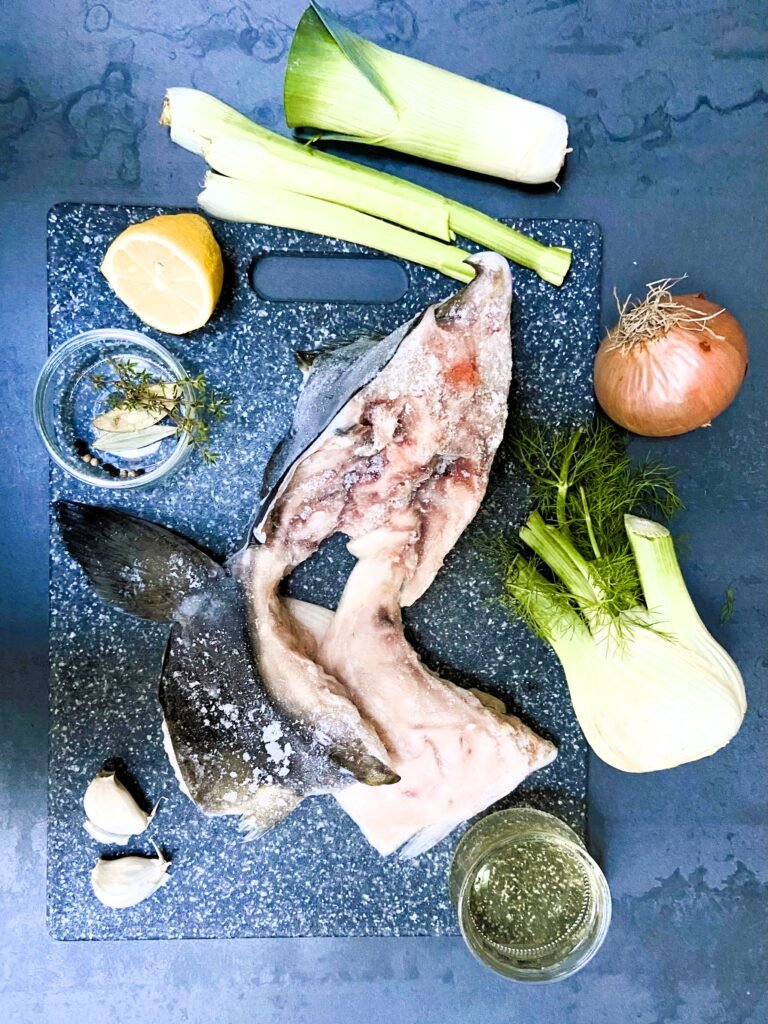
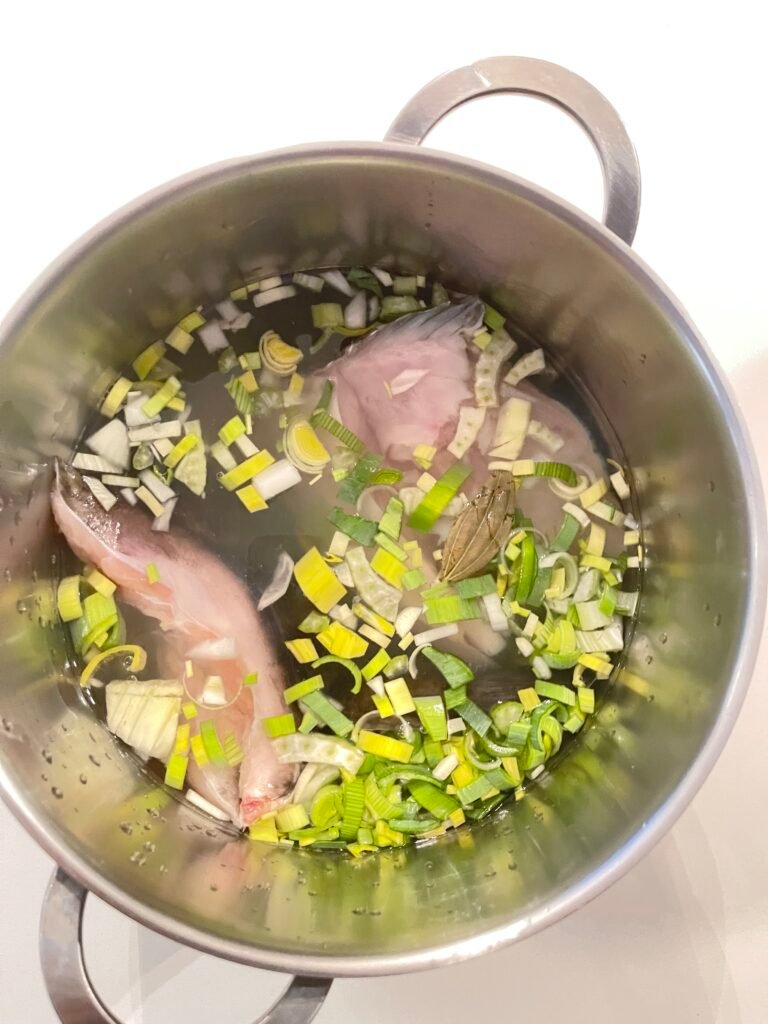
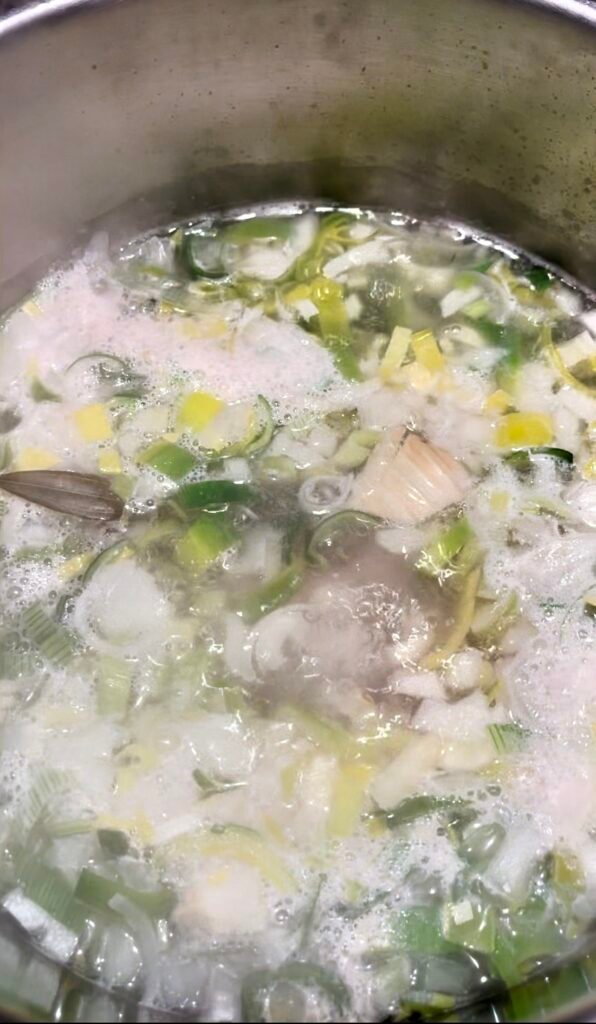
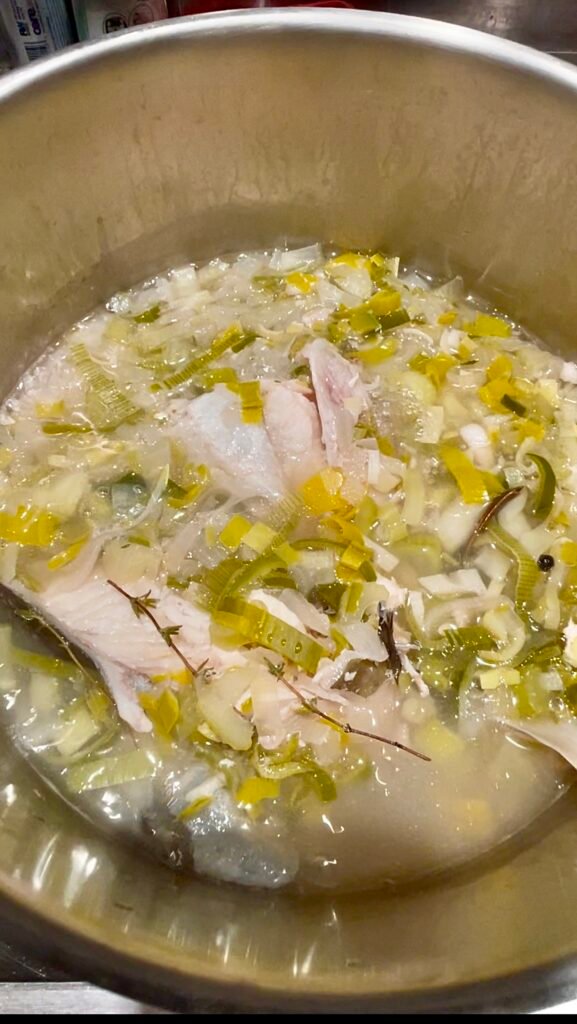
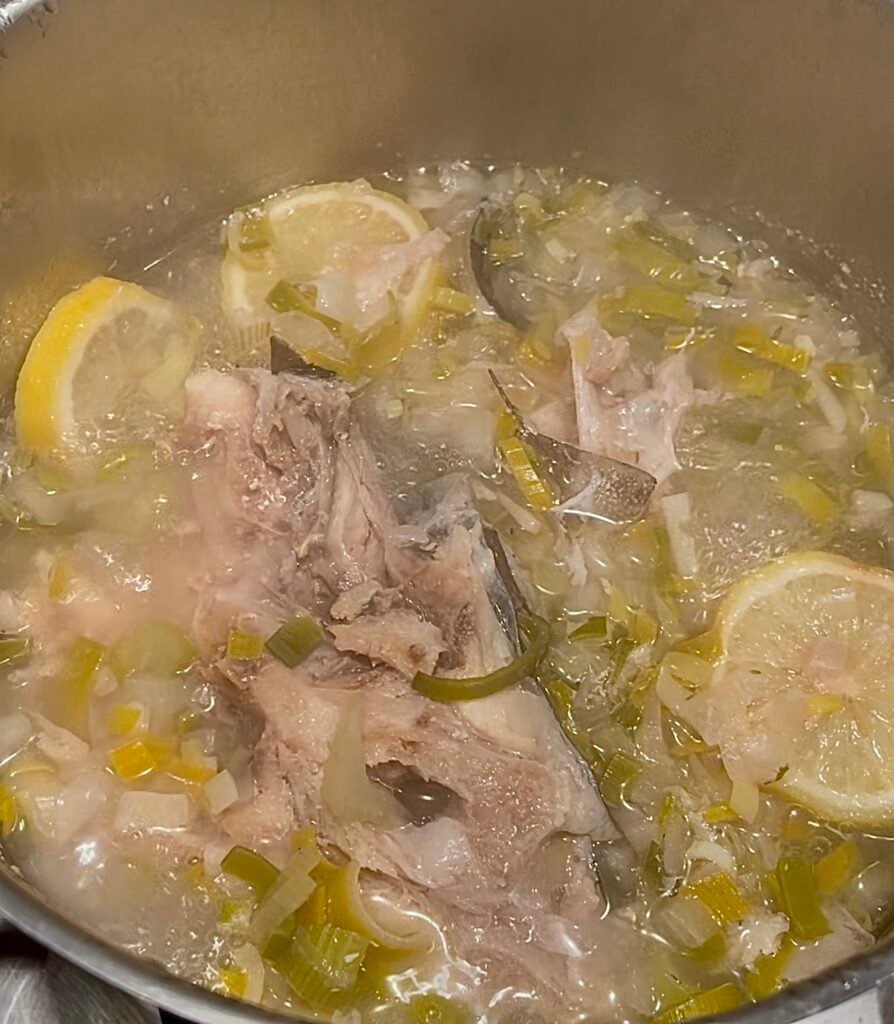
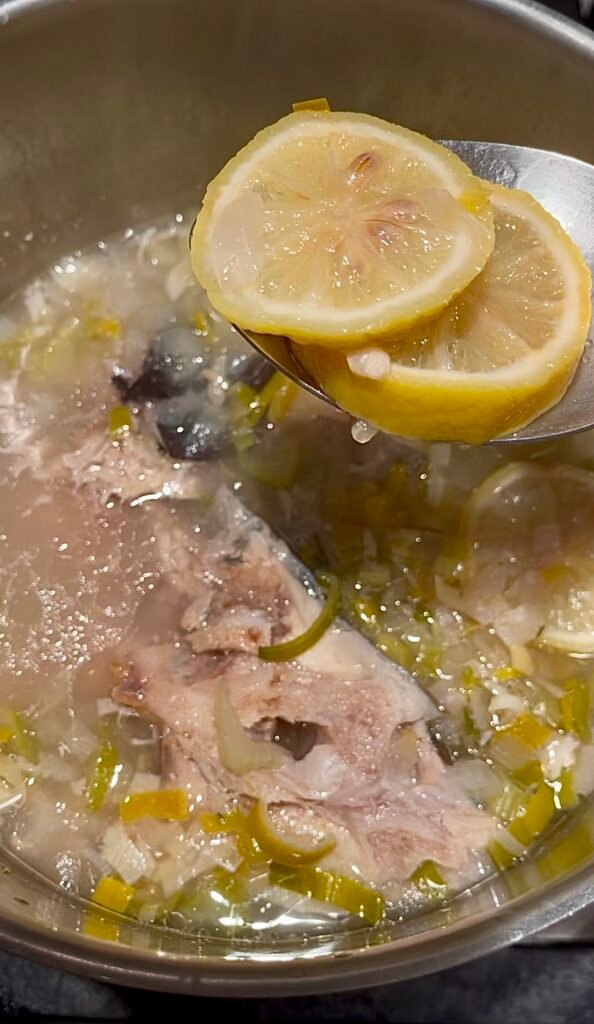
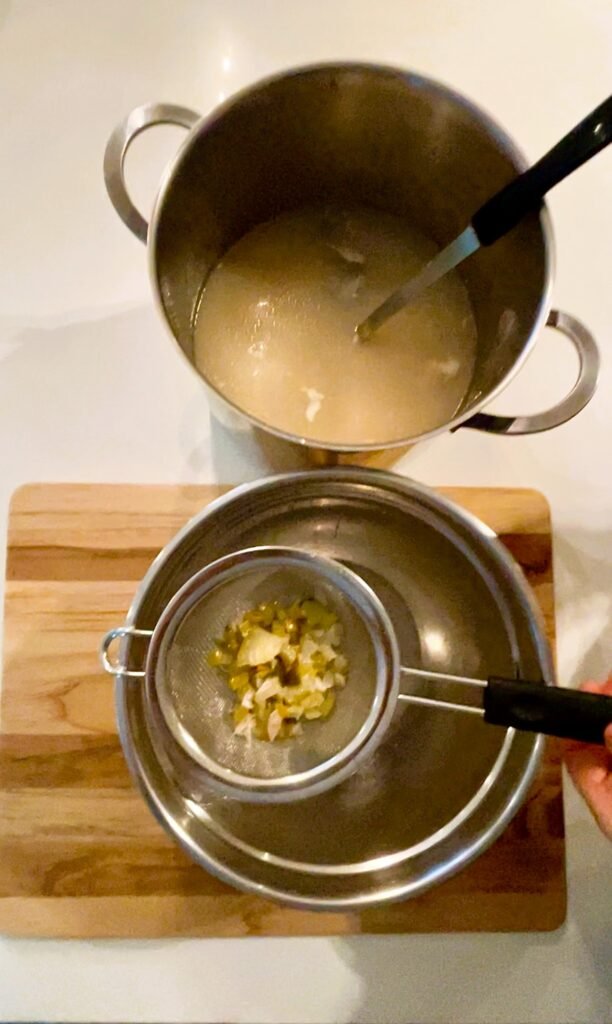
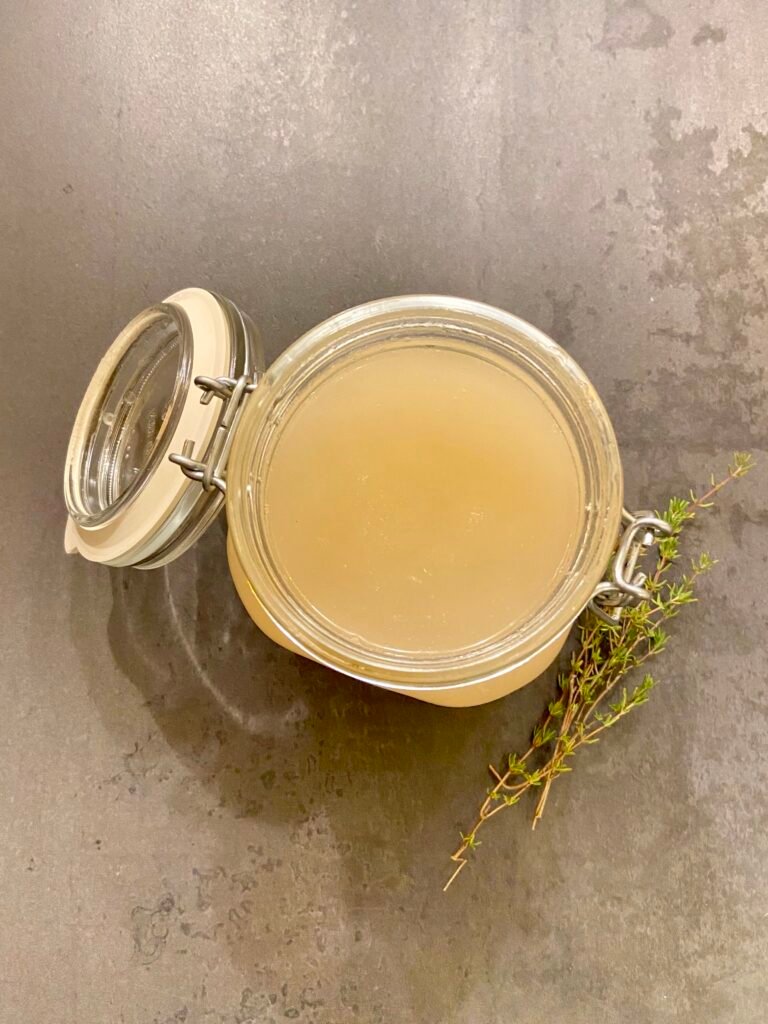
Easy Fish Stock Recipe
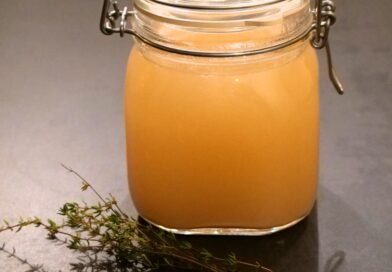
Ingredients
- 900 g 2 lb white fish trimmings (bones, heads, collars, fins)
- ½ yellow or white onion - roughly chopped
- 2 celery stalks - roughly chopped
- ½ small fennel bulb - roughly chopped
- 2 large garlic cloves - smashed
- water - enough to cover, about 8 cups
- 2 large leeks - white and light green parts only, roughly chopped
- ½ cup dry white wine
- 1 large bay leaf
- 10 black and white peppercorns
- 2 sprigs of thyme
- ½ lemon - sliced
Instructions
- Chop the Vegetables: Roughly chop the onion, garlic, celery, fennel bulb, and leeks.
- Combine Ingredients: In a large pot, add the fish trimmings, chopped vegetables, bay leaf, peppercorns, thyme, and white wine.
- Add Water: Pour in enough water to cover everything, about 8 cups.
- Simmer the Fish Stock: Place the pot over medium heat and bring it to a gentle simmer. Once it starts simmering, lower the heat to prevent boiling, which can make the stock cloudy. Simmer for 30 minutes, and skim off any foam that rises to the surface.
- Add Lemon: Add the sliced lemon to the pot and simmer for another 10 minutes.
- Steep for More Flavor: Turn off the heat and remove the lemon slices. Let the stock steep for another 30 minutes to deepen the flavors.
- Strain the Stock: Once the stock has developed its flavor, strain it through a fine mesh sieve into another pot or large bowl. You can discard the solids or press them against the sieve to get more mashed vegetable pulp into the stock, depending on your preference.
- Cool and Store: Let the stock cool completely before transferring it to airtight containers.
Refrigerate or Freeze:
- Refrigerate: Store the stock in the fridge for up to 3 days.
- Freeze: For longer storage, freeze the stock for up to 12 months. Divide it into smaller portions for easy use later.
- Defrosting: When you’re ready to use the frozen stock, thaw it in the fridge overnight or place the container in a bowl of cold water to speed up the process. Once defrosted, bring it to a simmer before using.
~
FAQs About This Fish Stock Recipe
Where to use fish stock?
Fish stock is a flavorful base for soups, stews, sauces, risottos, and seafood dishes such as Cioppino and clam chowder. Well-made homemade fish stock enhances the depth and richness of these recipes.
Do I have to use wine in this fish stock recipe?
Wine is an essential part of this fish stock recipe because it adds acidity and depth to the flavor. For that reason, we do not recommend omitting wine when making it.
If you must skip wine, try substituting it with a splash of lemon juice. Keep in mind, though, that the flavor of your fish stock will be different compared to one made with wine.
Can I Reuse the Fish Scraps for a Second Batch of Stock?
It’s not recommended to reuse fish trimmings for a second batch of stock. During the first simmer, most of the flavor, nutrients, and gelatin are extracted from the bones and other parts. As a result, the scraps will have little left to contribute in terms of taste or nutrition. A second simmer would likely produce a much weaker, less flavorful fish stock, which may not enhance your dishes as effectively.
Can this fish stock be canned?
The latest guidance from the National Center For Home Food preservations is that fish stock like this can be canned. However, you must use dial-gauge pressure canner or weighted -gauge pressure canner. If you decide to can this fish stock, make sure you are familiar with the recommended processing times for this sort of home preservation .

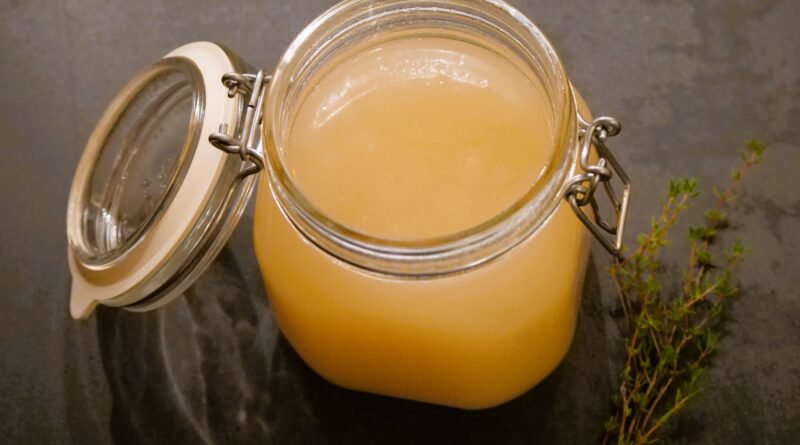


Leave a Reply